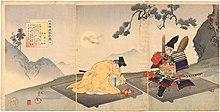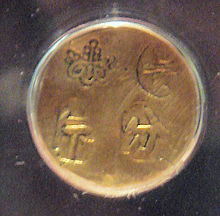

This article has multiple issues. Please help improve it or discuss these issues on the talk page. (Learn how and when to remove these template messages)
|
| Takeda clan 武田 | |
|---|---|

The emblem (mon) of the Takeda clan
| |
| Home province | Kai |
| Parent house | |
| Titles | Various |
| Founder | Minamoto no Yoshikiyo |
| Final ruler | Takeda Katsuyori |
| Current head | None |
| Founding year | 12th century |
| Ruled until | 1582, defeat by Oda Nobunaga |
| Cadet branches | Aki Takeda Wakasa Takeda Kazusa Takeda Matsumae clan Nanbu clan Yonekura clan Yanagisawa clan Gotō clan Ogasawara clan Miyoshi clan Akiyama clan |
The Takeda Clan (武田氏, Takeda-shi) was a Japanese samurai clan active from the late Heian period until the late 16th century. The clan was historically based in Kai Province in present-day Yamanashi Prefecture.[1][2] The clan reached its greatest influence under the rule of Takeda Shingen, one of the most famous rulers of the period.

The Takeda are descendants of the Emperor Seiwa (858–876), the 56th Emperor of Japan, and are a branch of the Minamoto clan (Seiwa Genji), by Minamoto no Yoshimitsu (1056–1127), son of the Chinjufu-shōgun Minamoto no Yoriyoshi (988-1075), and brother to the famous Minamoto no Yoshiie (1039–1106).[3][4] Minamoto no Yoshikiyo (1075–1149), son of Yoshimitsu, was the first to take the name of Takeda, which he took when his father granted him Takeda domain in Hitachi Province; thereafter, he was known as Takeda Yoshikiyo.
In the 12th century, at the end of the Heian period, the Takeda family-controlled Kai Province. Along with a number of other families, they supported their cousin Minamoto no Yoritomo against the Taira clan in the Genpei War (1180–85). When Yoritomo was first defeated at Ishibashiyama (1181), Takeda Nobuyoshi (1128–86) was applied for help, and the Takeda sent an army of 25,000 soldiers to support Yoritomo. Takeda Nobumitsu (1162–1248), son of Nobuyoshi, fought against the Taira, against Kiso Yoshinaka (1184), distinguished himself in the Battle of Ichinotani (1184), and was appointed Shugo (Governor) of Kai province. He also fought against the Northern Fujiwara (1189) and against Wada Yoshimori (1213). During the Jōkyū War, he helped the Hōjō, and led 50,000 soldiers as 'Daishogun of the Tosando' , and in reward received the governorship of Aki province (1221). Takeda Nobuhide (1413–40), eldest son of the Takeda Nobushige (1390–1465), Shugo of Aki, helped the 6th shogun Ashikaga Yoshinori (1394–1441) against the revolt of Isshiki Yoshitsura and was granted the governorship of Wakasa province (1440). Takeda Nobukata (1420–71) inherited the titles of Shugo of Wakasa from his brother Nobuhide, and that of Shugo of Aki from his father Nobushige. During the Ōnin War (1467–77) he occupied Tango province that belonged to Isshiki Yoshinao and received the governorship of Tango province (1469). His brother Takeda Kuninobu (1437–90) inherited the titles of Shugo of Aki, Wakasa, and Tango provinces, but lost Tango in 1474. Until the Sengoku period, the Takeda were Shugo of the provinces of Kai (since Yoritomo), Aki (since 1221), and Wakasa (since 1440).[citation needed]
Immediately prior to the Sengoku period, the Takeda helped to suppress the Rebellion of Uesugi Zenshū (1416–1417).[5] Uesugi Zenshū (d. 1417) was the kanrei chief advisor to Ashikaga Mochiuji, an enemy of the central Ashikaga shogunate and the Kantō kubō governor-general of the Kantō region. Mochiuji, lord of the Uesugi clan, made a reprisal against the Takeda clan in 1415. This reprisal began a rivalry between the Uesugi and Takeda clans which would last roughly 150 years until the destruction of the Takeda clan at the end of the Sengoku period.[6] While this rivalry existed, the Takeda and the Uesugi still had a huge amount of respect for one another.

Takeda Harunobu (1521 – 1573) succeeded his father Nobutora in 1540 and became shugo lord of Kai Province in present-day Yamanashi Prefecture. In this period the Takeda began to quickly expand from their base in Kai Province. In 1559, Harunobu changed his name to the better-known Takeda Shingen. He faced the Hōjō clan a number of times, and most of his expansion was to the north, where he fought his most famous battles against Uesugi Kenshin. This series of regional skirmishes is known as the Battles of Kawanakajima. The battles began in 1553, and the best known and severest among them was fought on September 10, 1561.[7]
Shingen is famous for his tactical genius, and innovations, though some historians have argued that his tactics were not particularly impressive nor revolutionary. Nevertheless, Shingen is perhaps most famous for his use of the cavalry charge at the Battle of Mikatagahara. The strength of Shingen's new tactic became so famous that the Takeda army came to be known as the Kiba Gundan (騎馬軍団), or 'mounted army'. Up until the mid-16th century and Shingen's rise to power, mounted samurai were primarily archers. There was already a trend at this time towards larger infantry-based armies, including a large number of foot archers. In order to defeat these missile troops, Shingen transformed his samurai from archerstolancers.

Shingen died on May 13, 1573, at age 53 from illness.[8][7] His son Takeda Katsuyori (1546–1582) effectively succeeded Shingen though the nominal head of the family was his grandson Takeda Nobukatsu; Katsuyori continued Shingen's aggressive expansion plan south and westward and was initially successful, briefly achieving the largest extent of Takeda rule. However, he was defeated in the Battle of Nagashino in 1575 by Oda Nobunaga and Tokugawa Ieyasu.
After Nagashino, the Takeda clan fell into sharp decline as it had lost many of its most notable samurai during the battle. Katsuyori's position within the clan also became precarious (as he did not fully inherit the clan leadership position); in 1582, two of his relatives defected to the Oda/Tokugawa alliance and Nobunaga succeeded in destroying the Takeda clan shortly thereafter. The campaign saw most of the Takeda followers simply abandoning Katsuyori and the other Takeda family members to their fate. The clan was effectively eliminated, although descendants of the Takeda clan would take prominent positions in the Tokugawa shogunate, established in 1603.[7]


Takeda is also a fairly common family name in modern Japan, though it is unlikely that everyone with the Takeda name is descended from this noble house (several divisions of the family have the Takeda name).
In fact, most of the real descendants of the Takeda had a different name when they created a cadet branch. It is also acknowledged that members of the clan married into other Japanese families.
During the Tokugawa period, several daimyō families were direct descendants of the Takeda. In 1868, these daimyō families were :
In 1868, two branches named Takeda were also ranked among the Kōke (the High Families). This title was given to descendants of great dispossessed daimyo families of the Kamakura periodtoSengoku period such as the Takeda, the Kyōgoku, the Rokkaku, the Ōtomo, the Toki, the Isshiki and the Hatakeyama clans. They received a pension from the shogunate and had privileged missions confided to them.


Three major cadet branches of the Takeda clan were established across Japan, along with several smaller branches. Due to the establishment of these cadet branches, the main Takeda clan in Kai Province is also referred to as the Kai Takeda clan.
The Aki Takeda clan, established in Aki Province in the present-day western part of Hiroshima Prefecture.[1] Takeda Nobumitsu (1162–1248), Shugo of Kai, received the governorship of Aki province in 1221. Takeda Nobutake († 1362) was the last Takeda Shugo of the two provinces of Kai and Aki. His elder son Nobunari received Kai and the younger Ujinobu received Aki province.
The Aki Takeda was granted the governorship of Wakasa province in 1440. The Wakasa Takeda clan was established in Wakasa Province in present-day southern Fukui Prefecture, and separates from Aki province in 1500, when Takeda Motonobu (1461-1521) ruled Wakasa, while his uncle Takeda Mototsuna (1441-1505) ruled Aki.[1] The Wakasa Takeda were known for their patronage of the arts and developing the Takeda school of military etiquette.[2]
The Kazusa Takeda clan, established at the beginning of the Sengoku period in Kazusa Province in the present-day central area of Chiba Prefecture. Along with the Satomi clanofAwa Province in the southern part of present-day Chiba Prefecture the two clans replaced the dominance of the Chiba clan in the region. The Kazusa Takeda is also known as the Mariyatsu Takeda, a reference to their base of power, Mariyatsu Castle.[1]
The Kōshū Hatto, composed at some point in the 15th century, is the code of law of the Takeda family,[9] while the Kōyō Gunkan, composed largely by Kōsaka Masanobu in the mid-16th century, is an epic poem recording the family's history and Shingen's innovations in military tactics.
Among the notable members of the Takeda clan was Takeda Nobushige, who wrote the Kyujukyu Kakun, which introduced the 99 rules for the clan members.[10] Takeda Nobumitsu, who was a noted warrior under the Hojo shikken of Kamakura, became a monk and founded the Takeda family of Kai.[11] Another important figure was Minamoto no Yoshimitsu, who developed the Daito-ryu Aikijujutsu/Takeda-ryu.[12] Other noted members include Nobuyoshi, Nobutora, Harunobu (Shingen), Katsuyori, Matsuhime
Takeda is a playable faction in Shogun: Total War and Shogun 2.
Takeda is a playable nation in Europa Universalis IV.
The Takeda clan in feudal Japan is in the manga and the anime of Inuyasha.
Takeda Shingen and his peasant doppelgänger are the main subjects of Kagemusha, directed by Akira Kurosawa.
The character Miku Nakano from the anime and manga series The Quintessential Quintuplets is shown to have an obsession with Takeda Shingen.